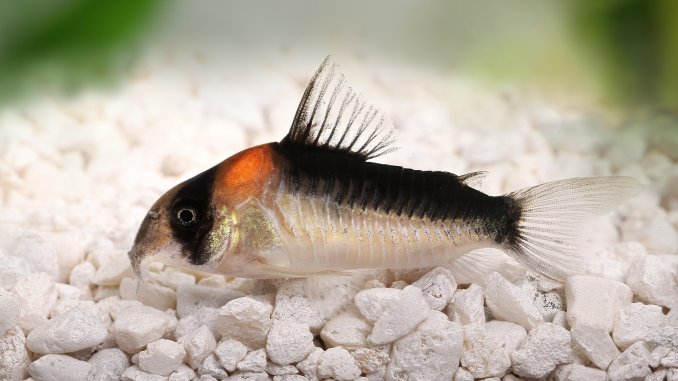
The cory catfish is a group of more than 160 freshwater catfish. These bottom-dwelling fish have short faces, armored white bodies with black spots, and barbels or whiskers around their mouths.
Cory catfish are peaceful, hardy fish that don’t harass their tank mates. The fish are popular amongst aquarists due to their calm temperaments and unique appearance.
TABLE OF CONTENTS
Cory Catfish Facts & Overview
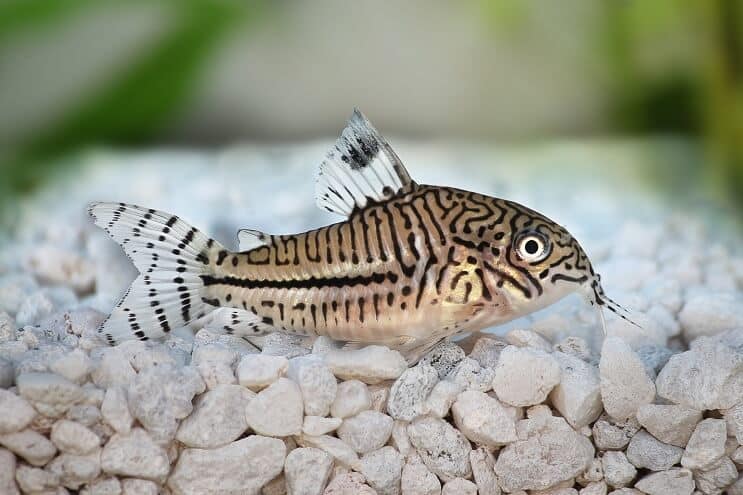
| Scientific name: | Corydoras paleatus |
| Common names: | Cory catfish, cory, cory fish, corydora catfish, corydora, armored catfish |
| Distribution: | Regions across South America |
| Size: | 1–4 inches |
| Life expectancy: | 3–5 years |
| Color: | Black, white, or brown, with dark spots or an orange stripe |
| Diet: | Omnivore |
| Temperament: | Peaceful |
| Minimum tank size: | 10 gallons |
| Temperature: | 70–78°F (21–25.5°C) |
| pH: | 5.5–7.0 |
| Hardness: | 5–10 dGH |
| Care level: | Easy |
| Breeding: | Egg-layer |
Origin
Cory catfish are found in regions all across South America, from the Andes Mountains to the Atlantic coast. The fish live in slow-moving, clear shallow streams with sediment and a sandy riverbed.
This natural habitat is partially shaded from light by dense overhead foliage. Plants grow abundantly in the waters.
Cory catfish are commonly found in the wild. The fish spend their time scavenging in the riverbed for food.
Adult Size & Lifespan
Fully-grown cory catfish reach up to 1–4 inches long. Females are longer than males and have wider bellies than males when viewed from above.
Male and female cory catfish live up to five years old, depending on the species of cory.
Availability
Cory catfish are widely available in pet stores and online. Some types of cory catfish are more popular than others. Panda cories, peppered cories, and similis cories are most commonly sold in the US.
The average cost of a cory catfish is $4–$8. You can find cory catfish for sale at the following online stores:
- LiveAquaria, which sells panda cory catfish, green aeneus cory catfish, peppered cory catfish, and similis cory catfish.
- Imperial Tropicals, which sells peppered cory catfish, panda cory catfish, sterba’s cory catfish, and albino cory catfish.
Appearance & Behavior
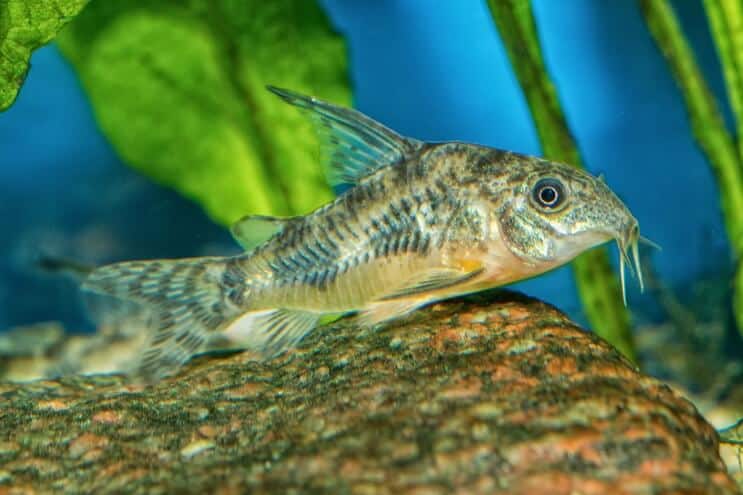
Cory catfish are bottom-dwelling fish that spend a lot of time hiding in caves or digging in the substrate. The fish come in neutral colors, such as brown, black, and gray, with various patterns.
Colors, Patterns, Fins, and Sex Differences
Cory catfish have armored bodies, which means their skin is protected by bony scales or plates. These fish have short faces, flat undersides, and dorsal fins that point upward like sails. The pectoral fins of a cory catfish stick out from the fish’s body and prop the fish up on surfaces.
Most cory catfish have forked tails, and the length and height of their tails depend on the cory fish species. They have wide, white-ringed eyes, and three sets of barbels on their faces which they use to scavenge for food in the substrate.
There are several camouflage color variations of the cory catfish, including brown, gray, and black. Pale, albino versions of cory catfish are also available.
There are more than 160 types of cory catfish. Some of the most common cory catfish, and their colors, are listed below.
- Panda cory catfish: Off-white or pinkish body with black splodges that resemble the giant panda’s markings.
- Peppered cory catfish: Tan or pale olive body with dark green-black markings and a green iridescent sheen.
- Similis cory catfish: Pale brown or white body with black dots and a black smudge toward the tail.
- Albino cory catfish: Albino variety of peppered cory catfish, with pinkish-white body and red eyes.
- Emerald cory catfish: Metallic green, turquoise or blue, with yellowish fins and a yellowish ventral area.
- Pygmy cory catfish: One of the smallest cory catfish species, with a silver body and a solid black horizontal line from nose to tail.
- Julii cory catfish: Pale brown or white body with black spots and a dark zigzag stripe on the lateral line from the gills to the tail.
- Sterba’s cory catfish: Dark brown body with white spots and white horizontal stripes.
When cory catfish are stressed, the fish’s colors become paler than usual. Some cory catfish change color to blend in with their environment.
Typical Behavior
Cory catfish are peaceful fish that hide at the bottom of the tank during the day, and shoal with other fish in the evening.
These fish have an adapted intestinal lining that allows them to take in oxygen from the air. Occasionally, cory catfish dart to the surface of the tank to breathe above the water.
Cory catfish are diurnal, meaning that they sleep at night and are active during daylight hours. The fish swim slowly in the bottom of the tank, searching for food in the substrate.
Cory Catfish Care & Tank Requirements
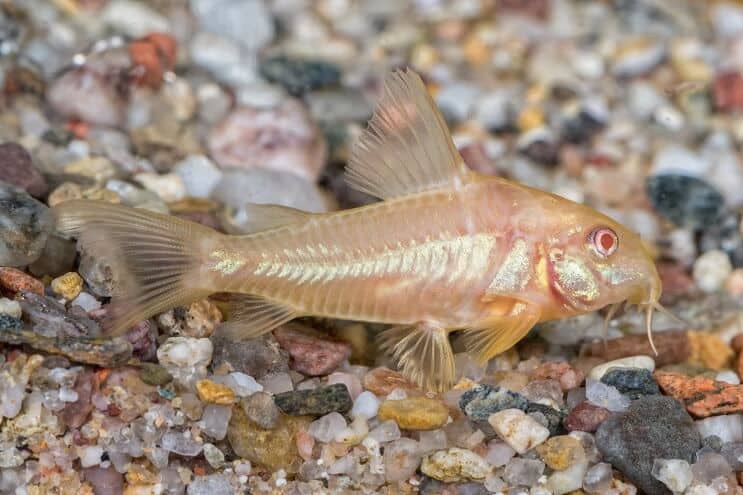
Looking after cory catfish is easy because the fish are hardy and peaceful.
Ensure the tank has the correct water parameters and suitable decorations for the cory catfish to feel at home in captivity. Feed the fish an omnivorous diet of foods that sink to the bottom of the tank.
Habitat and Tank Requirements
In the wild, cory catfish are found in shallow, vegetated, slow-moving freshwater streams. Replicate the fish’s natural environment in the tank to prevent stress and disease.
Most cory catfish are smaller than four inches long and require a tank size of at least ten gallons. When adding more than one cory catfish to the tank, ensure there is 1 gallon of water for every one inch of fish.
Soft, easy-to-dig sediment, like sand or rounded gravel, is a good substrate for a cory catfish tank. Avoid sharp gravel that could cut the fish.
Add plants to the aquarium to mimic the fish’s natural habitat and to oxygenate the tank. Amazon swords, penny warts, crypts, and dwarf hairgrass are suitable plants for cory catfish.
Provide caves and other hollow decorations at the bottom of the tank for cory catfish to hide in during the day.
Tank Conditions
The ideal tank conditions for cory catfish are:
| Water type: | Moderately soft, slow-flowing freshwater |
| Tank size: | Minimum 10 gallons, plus 1 gallon for every extra 1 inch of fish |
| Water temperature: | 70–78°F |
| Substrate: | Sand or fine gravel |
| Tank setup: | Plants, hollow decorations, caves |
| Acidity: | 5.5–7.0 pH |
| Water hardness: | 5–10 dGH |
| Filter: | Yes, to keep the tank clean and provide a slow-moving current |
| Pump: | Not necessary |
| Bubbler: | Yes, to oxygenate the tank |
| Lighting: | Yes, standard aquarium lighting to mimic the day-to-night cycle in the wild |
| Water heater: | Yes, to maintain a warm water temperature |
Aside from maintaining consistent water parameters, ensure the tank is clean and regularly tested for nitrates. High nitrite levels can cause stress and infections in cory catfish.
Disease
Cory catfish are prone to several common diseases in the aquarium:
Ich
Ich is a parasitic freshwater disease that causes white, itchy spots on a fish’s body. Diagnosing Ich in cory catfish is more difficult than in other fish because cory catfish are armored, which makes it hard to see white spots. Even if white spots aren’t noticeable, look for other signs of Ich, such as flashing (rubbing against rough surfaces in the tank), lethargy, and appetite loss.
Treat Ich by removing the affected fish and placing the fish in a quarantine tank with water that is a couple of degrees warmer than the home tank. Add one teaspoon of salt per gallon of water in the tank.
Red Blotch Disease
Red blotch disease is a common bacterial disease that occurs when fish are housed in poor tank conditions or transported in stressful shipping conditions. This disease is characterized by red, bloody blotches on the fish’s body, accompanied by blisters and dead skin.
To prevent red blotch disease, maintain desirable tank conditions, and use a soft substrate that won’t scratch the fish and increase the risk of bacterial infections. Add one or two teaspoons of tonic salt per gallon of water and use a broad-spectrum antibiotic like tetracycline to treat the issue.
Nitrite Poisoning
Although nitrite poisoning isn’t a disease, it’s one of the most common causes of early death in cory catfish. Nitrite poisoning occurs in poor water conditions when nitrite levels in the water aren’t properly managed. Cory catfish with nitrite poisoning swim sluggishly at the top of the tank.
To treat nitrite poisoning, complete a 25% water change and add nitrate and nitrite absorbers to the tank’s filter. Prevent future nitrite spikes by adding more plants to the tank and ensuring you don’t overfeed your fish.
Tank Mates

Cory catfish are shy, peaceful fish that can be paired with other peaceful aquarium fish that require the same water parameters. Don’t house cory catfish with aggressive or territorial fish, such as oscars and cichlids, which bully shy, slow-moving fish.
Good tank mates for cory catfish include:
- Tetras, like neon tetras and phantom tetras
- Guppies
- Mollies
- Swordtails
- Other catfish, like plecos and otos
Suitable non-fish tank mates for cory catfish include:
- Snails, such as nerite snails
- Filter shrimp, such as wood shrimp
- Small crabs, like fiddler crabs
Diet and Feeding
In the wild, cory catfish eat worms, larvae, vegetation, and small insects, which the fish scavenge for in the riverbed. Provide a similarly varied diet in the tank, using food that sinks to the bottom of the tank to replicate the cory catfish’s natural feeding habits.
Cory catfish dig and bury their faces in the substrate to suck up morsels of food. Sinking pellets, bottom-feeder tablets, and shrimp pellets are ideal foods for cory catfish. Vary the fish’s diet by providing algae wafers and live or frozen foods, like bloodworms and daphnia, twice a week.
Feed cory catfish once per day, providing enough food for the fish to eat within three to five minutes. Cory catfish take longer to eat than other fish because they spend more time hunting for their food in the substrate.
Leaving leftover food in the tank is fine because cory catfish will busily hunt for food in the substrate all day. However, be careful not to overfeed cory catfish because this will cause the fish to produce extra waste, increasing the tank’s nitrite levels.
Breeding
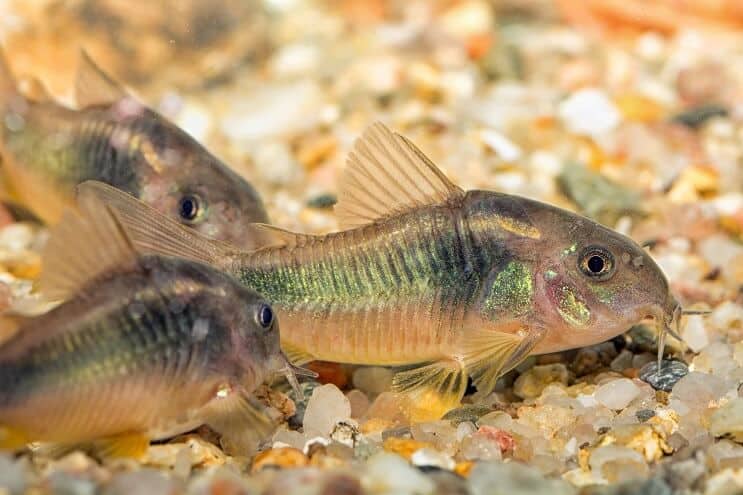
Breeding cory catfish is easy. If you’ve never bred fish before, cory catfish are good fish to start with. Most cory catfish become sexually mature at six to nine months old.
To breed cory catfish, follow these steps:
- Choose a healthy, active male and female cory catfish with normal coloring. Place the pair in a separate breeding tank with a sandy substrate and vegetation.
- Feed the fish live food, like bloodworms, and insects. This will simulate an approaching storm because insects are more active before storms, and fall into the water in the wild.
- Gradually reduce the water temperature until the breeding tank is three degrees colder than the home tank.
- If the male and female are interested in breeding, the female will become rounder than normal, indicating the development of eggs.
- The female will swim up to the male’s abdomen and the male will release sperm to fertilize the eggs. The female will lay the eggs in her pelvic fin, then choose a spot in the substrate to deposit the eggs.
- Once the female has spawned all the eggs, return the parents to the home tank to prevent the fish from eating their babies.
- Change the breeding tank’s water at least three times per day to protect the eggs from fungus. The eggs should hatch within six days.
- The hatched fry won’t need food for the first two to three days. Once the fry are swimming, feed the fry baby brine shrimp.
- When the fry have grown to 1 inch long, they can be added to your home tank or sold to your pet store.
Should You Get a Cory Catfish for Your Aquarium?
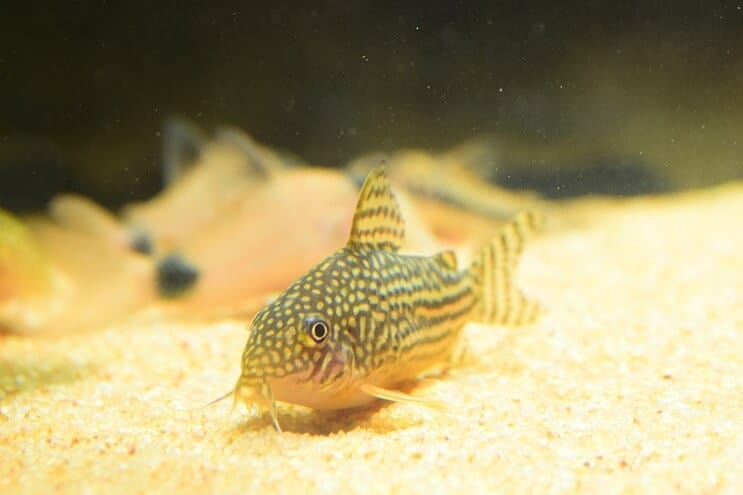
Cory catfish are laid-back fish that get on well with most other aquarium fish.
You should consider getting a cory catfish if your tank has clean water conditions, a soft substrate, plenty of hiding places, and peaceful tank mates. Don’t get a cory catfish if your tank houses aggressive fish or you have issues with nitrate or nitrite in the water.
There are many types of cory catfish to choose from, and all fish in this group are fun, interesting additions to a freshwater community tank.
Cory Catfish FAQs
- Can you keep bristlenose plecos with cory catfish?
- Will cory catfish kill my shrimp?
- Will cory catfish eat dead shrimp?
- Can I put three cory catfish in a 10-gallon tank?
- What do cory cats eat?
- Can corydoras live without sand?
- Do cory catfish need a bubbler?
- Do cory catfish eat algae?
- How often do cory catfish lay eggs?
- Why is my cory catfish turning white?
- Why do cory catfish swim to the top?
- How do you know if a cory catfish is stressed?
- Is gravel bad for cory catfish?
- Can cory catfish live with shrimp?
- Can cory catfish live with goldfish?
- How do I know if my cory catfish is dying?
- How many cory catfish can you put in a 10-gallon tank?
- Can you have a single cory catfish?
- How many cory catfish should be kept together?
- Do cory catfish clean the tank?

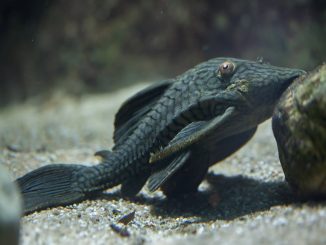

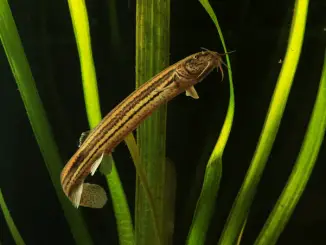
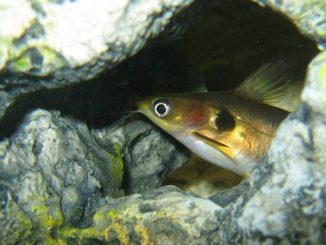
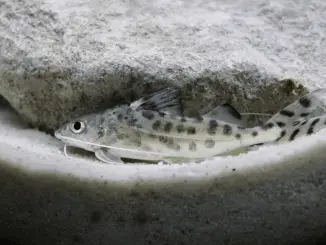
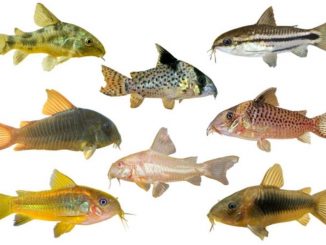
Thank you for your articles!
We have two trilineatus (1.1) and three ambiacus (0.1.2) in a heavily planted 10 gallon tank (!) and they get along better than fine. The male trilineatus is quite the stud and has fathered babies with both the spotted cory and with his own three-lined partner.
About once a week, the male trilineatus is hounding someone and we get a clutch laid by one female or the other. The trilineatus female dumped about 50 eggs again a couple days ago, but we left them in the tank…we’re out of space for new babies. About half of the trilineatus female’s eggs seem to hatch, while most of the spotted female’s eggs hatch, albeit she only lays about 15 at a time. They are in a tank with celestial danios and the babies don’t have much chance unless we take the eggs out prior to hatch. We have had only one baby avoid predation long enough to get big enough to be seen and evacuated.
Many eggs end up on the glass. We were able to save some of the eggs and raise 7 of the trilineatus x ambiacus in a separate container, and then saved some of the eggs from another pairing of the trilineatus and have about 11 trilineatus babies. Can’t wait to see the how the cross looks, but they really look almost exactly like their mother, the spotted cory, at this time (1″ long).
I don’t know the sex of the last two spotted corys, because they just hang out in the hide/cave and only come out to eat. They are smaller than the male trilineatus and I suspect they are beta males, and the plan is to separate the spotted and three-lined to take the pressure off.
Are there any non venemous cory catfish?
I don’t know which species I have, but they look like the first picture in your article on Corys with the black blotch on the dorsal and wriggly lines on the body. They are about 5.5cm. I have one female and two males in a 100L tank that I’m only gradually taking down, as so busy with other tanks it’s maintenance has been neglected. However, they mate regularly and the whole process has me glued to the tank. Both males try to push each other out of the way but she loves them both. Can somebody tell me what is going on when the male lies on his side and the female appears to be taking sperm from his side. Or underneath? I have only two healthy young but she always lays her eggs on the side of the tank and they get eaten by any living thing. I also have a 200L tank with three differant types of Corys. I’m not trying to breed them, they just do! I have a pair of three year old albinos in the 200L tank. They are not at all shy, don’t hide and as lively as the day I bought them. But I have never seen them mate. Nor have the other Corys cross bred as the trilineatus did. The albinos join in with the Clown Loaches when they decide to have one of their own tickling and kissing highly social sessions!
You might have a julii cory catfish.